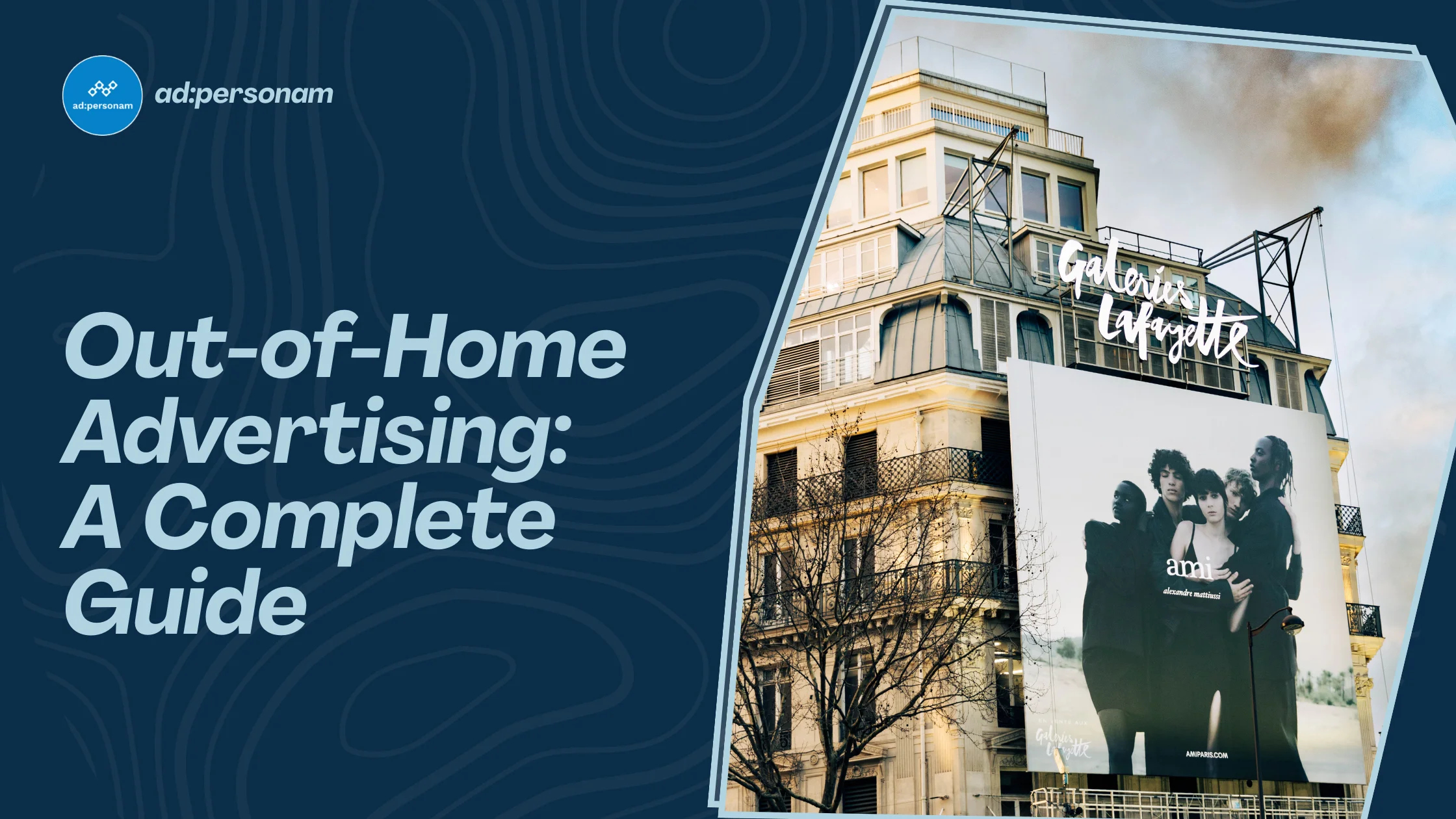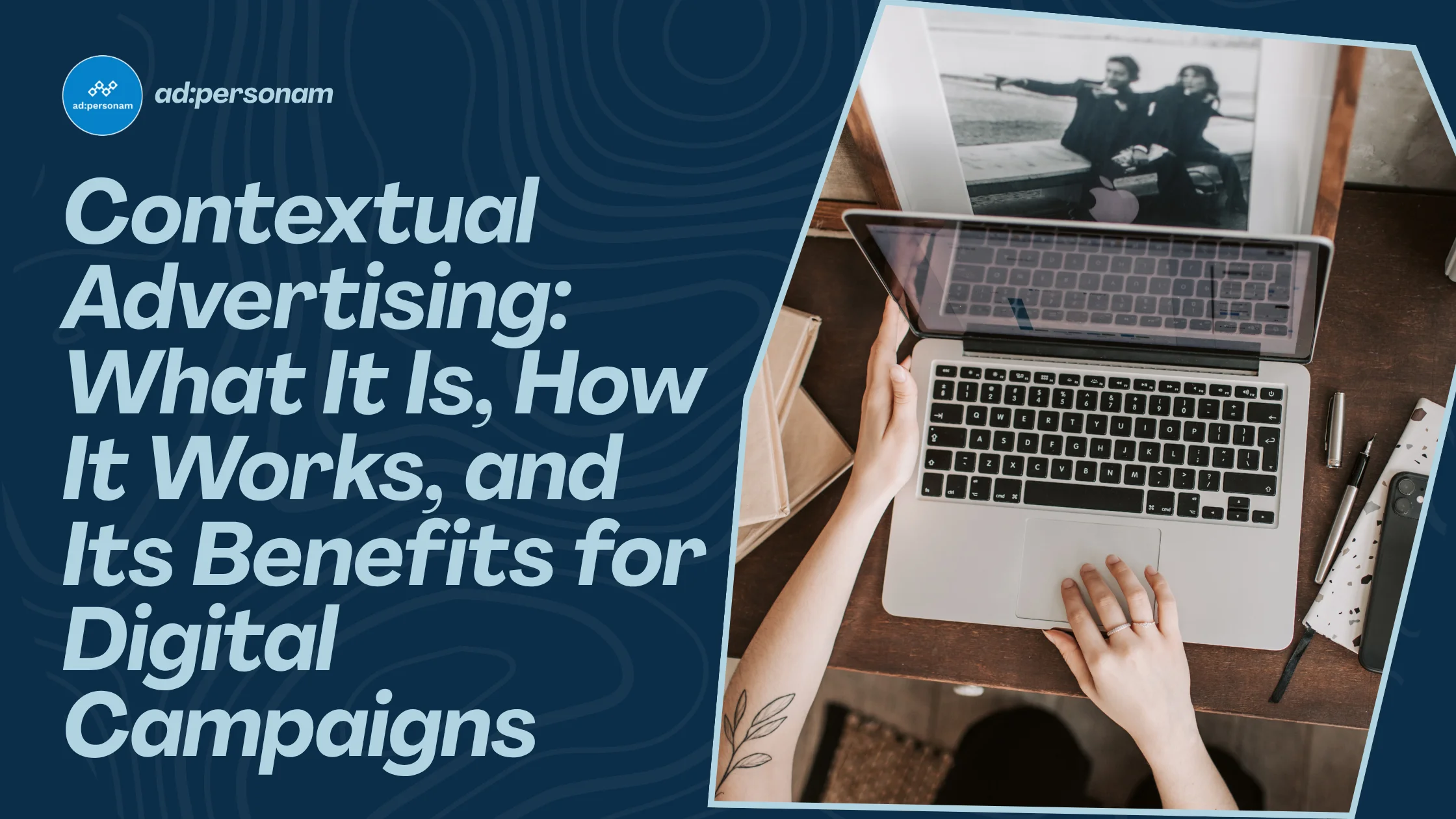Out of Home Advertising: Complete Guide to Programmatic OOH & DOOH
Learn how OOH and DOOH advertising work, key strategies for brand visibility, and how to run programmatic outdoor campaigns.
Contents
- Defining Out of Home Advertising
- What is Out of Home Advertising
- OOH vs Digital Advertising
- Main Types and Formats of Out of Home Advertising
- Digital Out of Home Advertising (DOOH): What It Is and How It Works
- Smart Out of Home (SOOH), AI, and Interactivity
- Why Out of Home Still Works: Key Advantages
- Pros and Cons of Out of Home Advertising
- When and How to Use OOH Advertising: Strategy and Use Cases
- Out of Home Metrics (KPIs and Measurements)
- Measuring ROI and Attribution for OOH/DOOH Campaigns
- Integration with DSP and Programmatic: Value for ad:personam Users
- Creative Best Practices for DOOH and OOH
- Costs, Pricing Models, and Budget Planning
- Regulations, Permits, and Privacy (GDPR) for DOOH
- Sustainability and OOH/DOOH (ESG Opportunities)
- Innovations and Future Trends (AI, AR, Data Integration)
- When to Choose OOH vs DOOH vs SOOH: Decision Guide
- FAQ on Out of Home Advertising

Out of home advertising encompasses all forms of advertising that reach people in public spaces. This guide is a practical resource for anyone who wants to leverage programmatic DOOH (Digital Out Of Home), using advanced technologies to buy and optimize outdoor advertising campaigns in a simple, automated way.
Defining Out of Home Advertising
Out of Home advertising (OOH) refers to all forms of advertising communication that occur in external public spaces, such as billboards, posters, and digital displays.
There's a key distinction between traditional OOH (static billboards, posters) and Digital Out of Home (DOOH), which uses programmable digital displays that can be updated in real-time. OOH is relevant for brand and performance marketing because it enables you to reach a vast audience with high visibility and impact, now integrating data and sophisticated targeting to maximize results.
What is Out of Home Advertising
OOH is based on physical formats displayed in environments such as streets, public transportation, and retail locations, designed to capture the attention of passersby or commuters. The basic format features large-scale visual exposures that create strong impact through size and strategic placement in urban or high-traffic contexts. These advertising mediums leverage permanence and context to increase brand awareness and message memorability.
OOH vs Digital Advertising
OOH typically has wide reach and prolonged exposure duration, but less granular measurability compared to digital advertising. Digital advertising enables real-time tracking, precise targeting, and immediate actions, while OOH works on frequency and reach in physical environments, generating awareness that's difficult to replicate online.
Main Types and Formats of Out of Home Advertising
The most common OOH formats include 6x3 posters, dominators, bus stop panels, shelters, transit advertising on public transportation, billboards, street furniture, and point of sale displays.
Each format has specific uses: for example, posters and billboards are ideal for large-scale awareness campaigns; bus stop panels and shelters work well for local promotions and proximity contexts. Strengths vary from lower costs and wide visibility to limitations such as seasonality or effectiveness tied to physical location.
Digital Out of Home Advertising (DOOH): What It Is and How It Works
DOOH uses digital displays for the dynamic delivery of advertising content, enabling real-time updates through scheduling and variable content feeds. It integrates external data such as weather, time, and events to adapt messaging in real-time. Measurability is enhanced by technologies that track mobile devices and foot traffic (footfall).
DSPs like ad:personam enable you to buy DOOH inventory programmatically with a self-serve platform and AI optimization, bringing speed and precision to campaign execution.
Smart Out of Home (SOOH), AI, and Interactivity
SOOH represents the evolution of OOH with real-time personalization, augmented reality (AR), virtual reality (VR), and interactions via QR codes, NFC, or gestures.
Messages adapt dynamically to parameters like time of day or weather conditions. AI optimizes creative strategies and bidding, making advertising more relevant and engaging for audiences.
Why Out of Home Still Works: Key Advantages
OOH maintains a competitive advantage through high reach and frequency, with a physical impact that's hard to ignore. It effectively integrates marketing funnel stages, from awareness to conversion, especially when combined with coordinated digital campaigns.
Recent statistics indicate that over 80% of consumers remember an OOH ad they've seen, and that DOOH grew by 19% in 2024 in the Italian market.
Pros and Cons of Out of Home Advertising
| Pros | Cons |
|---|---|
| High visibility and impact | More limited measurability compared to digital |
| Wide coverage and frequency | High production costs for traditional formats |
| Various formats for different objectives | More complex scalability without digitization |
| Integration with data and mobile | Complex attribution, requires hybrid methods |
Limitations related to hybrid attribution can be mitigated through QR codes or UTM parameters and footfall tracking.
When and How to Use OOH Advertising: Strategy and Use Cases
Choosing the format and timing depends on objectives: awareness, product launches, or local promotions. We recommend adequate campaign duration with calibrated frequency and synchronization with other digital channels (search, social). Best practices include pilot tests, A/B testing of creative assets, and programmatic dayparting to optimize effectiveness.
Out of Home Metrics (KPIs and Measurements)
The primary metrics are estimated impressions, offline viewability, dwell time, incremental visits, and conversion lift. CTR can be evaluated through QR codes or scans. CPM and effective CPM are calculated considering visibility and interaction, critical data for evaluating the value of OOH and DOOH campaigns.
Measuring ROI and Attribution for OOH/DOOH Campaigns
Methodologies include footfall analytics analysis, mobile location data, and tracking of coupons or QR codes. Incrementality testing and data integration with CRM and analytics enable you to quantify sales attributed to OOH, ensuring precise analysis of return on investment.
Integration with DSP and Programmatic: Value for ad:personam Users
With ad:personam, you can create fully programmatic DOOH campaigns with a complete workflow: target definition, budget setting with no minimum spend, bidding strategies, creative feeds, AI-based live optimization, and detailed reporting.
The self-serve platform offers total control, speed, and intelligent AI optimization, making DOOH accessible and productive. We also remind you that ad:personam requires no minimum spend for access, making the platform even simpler and more secure.
Creative Best Practices for DOOH and OOH
To maximize impact, messages must be short and readable from a distance. Using motion and animations increases attention, while concise calls to action with QR codes or short links facilitate interaction. We recommend testing static and animated versions, preferring 3-second templates, using strong contrasts, clear fonts, and appropriate sizes.
Costs, Pricing Models, and Budget Planning
The most common models are CPM and space rental. Production costs and DSP fees must be considered in planning. Budget varies based on market (cities vs regions). We recommend starting with contained budgets to test campaigns before scaling up.
Regulations, Permits, and Privacy (GDPR) for DOOH
Static postings require municipal permits. Regulations limit certain creative content and regulate sensors and data collection. GDPR mandates anonymization, privacy by design, and consent when necessary for tracking and use of personal data.
Sustainability and OOH/DOOH (ESG Opportunities)
The comparison between print and digital highlights lower energy consumption and waste for digital media. Recyclable materials and low-impact systems are utilized. Communicating ESG commitment in campaigns must avoid greenwashing and focus on transparency and concrete actions.
Innovations and Future Trends (AI, AR, Data Integration)
Trends include AI for creative optimization and bidding, AR for immersive engagement, integration with IoT and real-time data, and privacy-first targeting. The "future of DOOH" envisions increasingly personalized and interactive campaigns, with advanced measurability.
When to Choose OOH vs DOOH vs SOOH: Decision Guide
Traditional OOH for broad long-term awareness campaigns with variable budgets; DOOH for dynamic, data-driven campaigns with flexibility and measurability; SOOH for advanced interactivity and real-time personalization, ideal for innovative campaigns with high engagement.
FAQ on Out of Home Advertising
What is Outdoor Advertising?
It's advertising communication in public places, including posters and digital displays, designed to reach people on the move and increase brand awareness, now integrated with programmatic advertising like ad:personam.
What are OOH Activities?
They include traditional postings, transit advertising, outdoor digital signage, urban installations, and retail location screens, increasingly managed with programmatic digital platforms for effective targeting and measurement.
What is Digital Out of Home (DOOH)?
It's the digital evolution of OOH with LED displays and dynamic totems, updatable in real-time and based on contextual data. It enables self-service purchasing, AI optimization, and advanced measurement through platforms like ad:personam.
Try other features of our programmatic advertising platform and launch your advertising campaigns!
You might also like

Contextual Advertising: The Complete Guide to Privacy-First Targeting
Discover how contextual advertising delivers effective, privacy-compliant campaigns without cookies. AI-powered targeting for the cookieless era.

Programmatic Advertising Trends in Italy: Growth and Key Insights for 2025
Explore the key programmatic advertising trends in Italy and discover growth opportunities shaping the market through 2025 and beyond.

Demand Side Platforms: What DSPs Are and How They Work
What are DSPs, how do they work and why use them in programmatic marketing? Discover how you can test ad:personam to create effective campaigns with complete autonomy, in self-service mode.